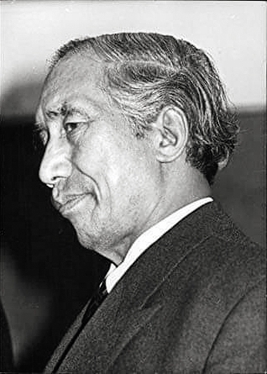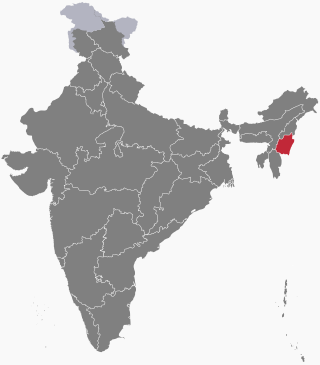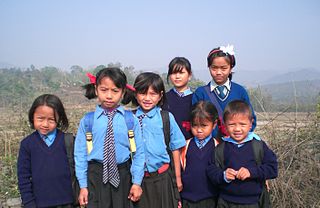
The Insurgency in Northeast India involves multiple separatist militant groups operating in some of India's northeastern states, which are connected to the rest of India by the Siliguri Corridor, a strip of land as narrow as 14.29 miles (23.00 km) wide.

Zapu Phizo, commonly known as A. Z. Phizo or Angami Zapu Phizo, was a Naga nationalist leader with British nationality. Under his influence, the Naga National Council asserted the right to self-determination which took the shape of armed resistance after the Indian state imposed the Armed Forces Special Powers Act in 1958. Naga secessionist groups regard him as the "Father of the Naga Nation".

The National Socialist Council of Nagaland (NSCN) is a Naga militant and separatist group operating mainly in northeastern part of India, with minor activities in northwest Myanmar (Burma). The main aim of the organisation is allegedly to establish a sovereign Naga state, "Nagalim", which would consist of all the areas inhabited by Naga tribes in Northeast India and northwest Myanmar. India claims that China and Pakistan provide financial support and weaponry to the NSCN. Drug trafficking and extortion are believed to be other major sources of income for the NSCN.
The Naga National Council (NNC) was a political organization of Naga people, active from the late 1940s to the early 1950s. It evolved out of the Naga Hills District Tribal Council, an organization established in 1945 by the Deputy Commissioner of the Naga Hills district. The group was reorganized to form NNC in 1946 at Sanis, with Eno T. Aliba Imti Ao as the President, and other democratically elected Naga representatives as its members. NNC declared independence a day before India's independence on 14 August 1947, and unsuccessfully campaigned for the secession of the Naga territory from India.
Naga nationalism is an ideology that supports the self-determination of the Naga people in India and Myanmar, and the furtherance of Naga culture.
Longri Ao (1906–1981), also known by name Longritangchetha, was an indigenenous Baptist missionary from the North-Eastern state of India, Nagaland. He was a missionary to the Konyak people and a peacemaker. He is known to have risked his life to restore peace in Nagaland, and to negotiate a ceasefire agreement between the Government of India and underground leaders fighting for Nagaland secession from India.
The Shillong Accord of 1975 was an agreement signed between the Government of India, also referred to as the Federal government, or Union government, or Central government of India, and Nagaland's underground government, also referred to as the Naga Federal government, or Naga guerillas, or Naga rebels, to accept the supremacy of Constitution of India without condition, surrender their arms and renounce their demand for the secession of Nagaland from India.

The Insurgency in Manipur is an ongoing armed conflict between India and a number of separatist rebel groups, taking place in the state of Manipur. The Insurgency in Manipur is part of the wider Insurgency in Northeast India; it displays elements of a national liberation war as well as an ethnic conflict.
Thuingaleng Muivah is an Indian politician and General Secretary of the National Socialist Council of Nagaland(I-M).
The Naga Peace Accord is a peace treaty, signed, on 3 August 2015, between the Government of India, and the National Socialist Council of Nagaland (NSCN), to end the insurgency in the state of Nagaland in Northeast India. The Government’s interlocutor for Naga Peace Talks, R. N. Ravi signed it on behalf of the Government of India, whereas Lt. Isak Chishi Swu, Chairman and Thuingaleng Muivah, General Secretary signed on behalf of the NSCN, in presence of the Indian Prime Minister, Narendra Modi.
Isak Chishi Swu was the chairman of the Nationalist Socialist Council of Nagaland (NSCN). He along with Thuingaleng Muivah and S. S. Khaplang were instrumental in the creation of NSCN on 31 January 1980 after opposing the 'Shillong Accord' signed by the then Naga National Council (NNC) with the Indian government. He was unable to attend the historic Naga Framework Agreement signed on 4 August 2015 due to health conditions.

Shangwang Shangyung Khaplang was a Burmese leader of Naga ethnicity. He was the leader of the NSCN-K, an insurgent group that operates to establish a Greater Nagaland, a sovereign state bringing all Naga-inhabited areas of Myanmar and India under one administrative setup.

The hill tribes of Northeast India are hill people, mostly classified as Scheduled Tribes (STs), who live in the Northeast India region. This region has the largest proportion of scheduled tribes in the country.
Khodao Yanthan was a Naga liberation leader and a member of the Naga National Council (NNC). He was popularly called, “the grand old man of Naga political struggle”.

The history of the Nagas dates back centuries, but first appear in written records of Ahom kingdom during the medieval period of Indian history. Aside from developing contacts with the Ahom kingdom, which was established in 1228 in Assam, the Nagas generally lived an isolated existence from the outside world. This changed in the 19th century, when the Burmese Empire launched several invasions of Assam between 1817 and 1826, which led the Nagas to briefly fall under Burmese rule. However, the neighboring British Empire annexed Assam in 1828 following the 1826 Treaty of Yandabo.
Elections to the Nagaland Legislative Assembly were held in February 1998 to elect members of the 60 constituencies in Nagaland, India. The Indian National Congress won a majority of the seats and S. C. Jamir was re-appointed as the Chief Minister of Nagaland. The number of constituencies was set as 60 by the recommendation of the Delimitation Commission of India.
Perietsü Kevichüsa Meru, commonly known as Tubu Kevichüsa was a politician from Nagaland, India who served as the General Secretary of Naga National Council until his assassination in June 1996 by armed men from the NSCN-IM. His brother Chalie Kevichüsa was also assassinated by the NSCN-IM in September 1992.
This is a timeline of the history of the Nagas.
The 2011 Tirap Ambush was a violent clash within the National Socialist Council of Nagaland (NSCN) between the NSCN--Isak Muivah (NSCN-IM) and the NSCN--Khaplang (NSCN-K) militant groups on the Indo-Myanmar border of Tirap district, in Eastern Arunachal Pradesh, India.







